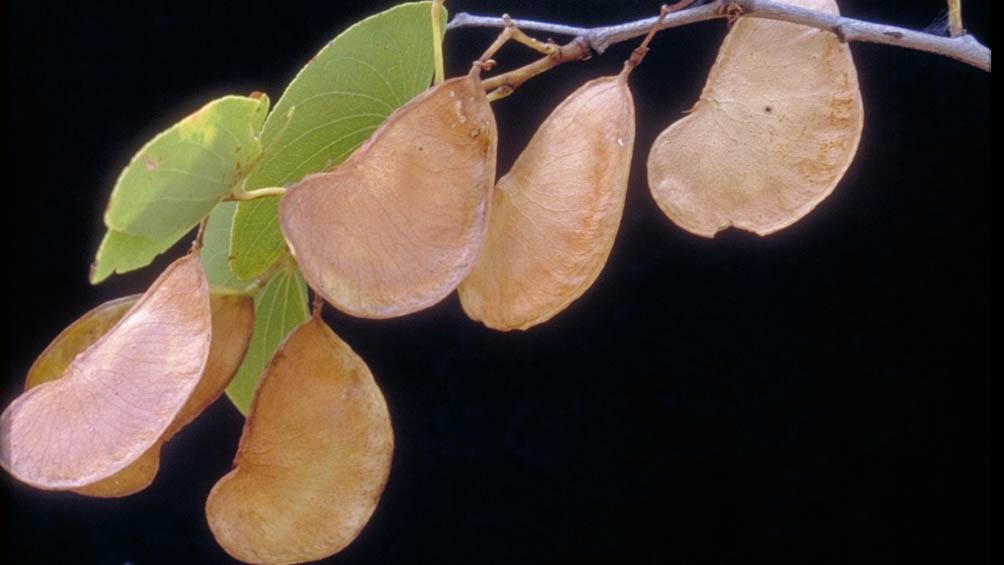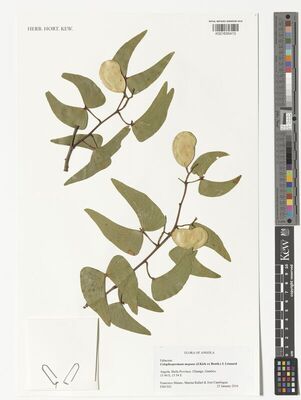Geography and distribution
This species occurs in an area exceeding 500,000 km² in south-central Africa, which includes southern Angola, northern Namibia, northern Botswana, Zimbabwe, southern Zambia, southern Malawi, northern South Africa and Mozambique.
Description
Overview: Colophospermum mopane occurs in a variety of forms depending on local environmental conditions. These range from a small stunted form, usually not more than 2 m tall, which does not produce fruit, to a fruit-bearing tree of 20 m in height.
Leaves: The leaves comprise a single pair of leaflets, each measuring about 5 to 10 cm long by 2.5 to 5 cm wide.
Flowers: The flowers are greenish, inconspicuous and about half a centimetre long.
Pods: The pods are pale brown, flattened and up to 6 cm long and 3 cm wide.
The species grows gregariously, meaning that many individuals grow together to the near or complete exclusion of other plant species. The pollen is thought to be carried on the wind. This method of pollination is often associated with inconspicuous flowers because plants that do not require an insect or animal to pollinate their flowers, do not need to develop conspicuous flowers to attract the pollinator.
Threats and conservation
This widely distributed species is not currently a conservation concern.
Uses
The principal uses of Colophospermum mopane include timber, fuel wood, animal browse in the dry season (but it is also used for fodder), medicine, tannins, resins and soil stabilisation.
Colophospermum mopane is of great value in southern and south central Africa. It is an important species in savanna and woodland ecosystems, providing important resources for people, animals, insects and the soil.
The greatest biocultural value placed on mopane is for fuel and timber. A recent study showed that families in the rural north-east of South Africa harvest up to 8 kg of mopane a day for fuelwood. The timber is used for fencing and construction; it is known to be durable and resistant to insect damage.
Colophospermum mopane is a vital constituent of mopane woodland, providing browse for elephants and other herbivorous animals. It is the host plant of the mopane worm, the larva of the moth Acanthocampa belina . The large caterpillars measure up to 8 cm in length. They are an important food source in Botswana and are a highly sought after and protein-rich delicacy.
Millennium Seed Bank: Seed storage
Kew's Millennium Seed Bank Partnership aims to save plant life world wide, focusing on plants under threat and those of most use in the future. Seeds are dried, packaged and stored at a sub-zero temperature in our seed bank vault.
Number of seed collections stored in the Millennium Seed Bank: Four
Seed storage behaviour: Orthodox - the seeds of this plant survive being dried without significantly reducing their viability, and are therefore amenable to long-term frozen storage such as at the MSB
Germination testing: Successful
Composition values: Oil content 10%
Cultivation
Colophospermum mopane is grown at Kew in a mix that is high in organic matter. The mix also contains perlite, granular fertiliser and Seramis. The zone in which the pot is kept is heated to 24 ˚C during the day and 18 ˚C at night. In the winter however the zone is simply kept frost-free to simulate temperate conditions. Soil moisture is checked daily but usually the species will only require water twice a week in these conditions. Feeding is carried out twice a week. This consists of a foliar feed and a liquid applied to the root zone. This species is grown under bright light, with very little shading used. Colophospermum mopane has not yet flowered at Kew.
This species at Kew
There is one specimen of this woody plant at Kew, growing in the Jodrell Glasshouses, one of Kew's behind-the-scenes areas.
A host to noisy, yet delicious, caterpillars!
Trees of Colophospermum mopane often play host to the mopane worm which is the larval form of the moth Acanthocampa belina . Caterpillars eating the protein-rich leaves of Colophospermum mopane sometimes occur in such large numbers that the sound of their feasting can be heard from several metres away. The large caterpillars measure up to eight centimetres long! They are a highly sought after local delicacy and are rich in protein.














